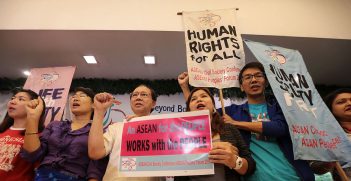Cooperation And Coordination in A Context of Animosity? East Asia, Peacekeeping Operations And Humanitarian Assistance And Disaster Relief

East Asia is increasingly being considered as a region which is a potential crucible for conflict. Even the most optimistic authors recognise that there is the potential for security tensions to develop into more comprehensive kinetic actions.
Questions of when, why and how states cooperate, coordinate, or develop more enduring partnerships fill the pages of the literature on International Organisations, Institutions, and Regimes. In East Asia, the exceptional nature of the region’s organisations both defy and affirm expectations of scholars found in the wider International Relations (IR) literature the region provides evidence of both cooperative practices and conflict and tensions between states. This has led to the conclusion that the Association of Southeast Asian Nations (ASEAN) and its associated organs continue to challenge researchers. These challenges have resulted in “ASEAN boosters”, and “ASEAN bashers”, or as Richard Stubbs has termed them “sceptics” and “proponents” who despite drawing on the same events and institutions draw different conclusions.
In the broader East Asia context (incorporating China, Japan and South Korea) too, there is a challenge to researchers. Instances where IR theories and theorists may expect greater cooperation (e.g. in the relationship between South Korea and Japan) and instances where they would expect greater tensions such as between China and South Korea. As a result, there is a need for new approaches to researching the contribution of practices of cooperation and coordination within this region or, as argued by Foot and Goh, a need to develop a new research agenda which more appropriately reflects the particular and non-western relations of the component states and their peoples.
This issue is, therefore, focused on the specific issue of how we can understand the emergence and limits of regional cooperation in a context of increasing animosity and tensions between regional and extra-regional states. Consequently, it picks up the argument of Alice Ba when she stated that ASEAN’s contributions to regional security have been “critical but also very specific, constrained, and far from comprehensive.” This issue identifies a particular and specific claim that in areas of non-traditional security cooperation between states should be considered to be “low-hanging fruit”.
The research puzzle
East Asia (here consisting of China, Japan, North and South Korea, and the ten states of the ASEAN) is increasingly being considered as a region which is a potential crucible for conflict. Even the most optimistic authors recognise that there is the potential for security tensions to develop into more comprehensive kinetic actions. In the context of the growing trade tensions between China and the United States, which is drawing in other regional actors, the potential for economic interdependence to mitigate these tensions is reducing. As noted by Sohn, the nexus between economics and security may produce both positive and negative reinforcement. In this emerging political space, it would not be expected that cooperation and coordination bridging across these lines of tensions would emerge—especially in a region characterised by weak or soft regionalism where the efficacy of the regional institutions is perpetually challenged.
Despite the context in this region we do, however, see evidence of cooperation and coordination emerging within the arena of (so-called) non-traditional security challenges. These issues are defined as challenges that are transnational in nature but present an existential threat to populations and their well-being. As such, these challenges encompass climate-related disasters, food and water security, resource scarcity, transnational crime, smuggling. As Martel notes, combating these challenges are often seen as the “low-hanging fruit” of regional cooperation. These challenges are, therefore supposed to be the “doable”; the easy to achieve targets that may then move from building confidence between states towards enduring cooperation. This is not only the case with the ten ASEAN states but also draws in the wider regional states of China, Japan and South Korea in the ASEAN Plus Three (APT) grouping and through the ASEAN Regional Forum (ARF).
Based on these sets of arguments the literature would present two sets of expectations: first, in the area of hard or traditional security tensions may continue to increase increasingly less mitigated by (and perhaps exacerbated by) the “Asian Paradox”; second, in the area of non-traditional security (common challenges not threatening state survival), we would expect to see gradual increasing cooperation and spill-over effects from building of confidence and trust between states.
This issue then is concerned with examining this second expectation in the context of emerging animosity among the states of the region and concerned with the region regarding these issues (in particular, those states outlined at the outset but also including Australia, New Zealand, and the United States). The findings of these papers indicate that there is a policy/practice divide and whereas there are confidence-building and trust mechanisms emerging at the practice and implementation level, despite policy pronouncements there is a lack of functional spill-over to developing policy-level coordination.
Events and patterns of cooperation and coordination
In November 2013, Super Typhoon Haiyan (local name Yolanda) devastated 44 provinces of the Philippines, displacing approximately 4.4 million people and over 1 million houses destroyed and claimed over 6,300 lives. In assessments of the local, regional and global responses to this disaster it became clear that the perceived disaster response was both slow and inadequate and raised issues of coordination and cooperation although the response from the international community was relatively swift.
In the years preceding and subsequent to this disaster, there have been numerous attempts to develop a more concerted and coordinated regional response. As demonstrated in the responses to the earthquakes in Indonesia in 2018 and the burst dam in Laos in the same year, it is increasingly evident that the first responders from across the civil–military divide (local communities, national armed forces, non-governmental organisations [NGOs]) have developed more coordinated functional relationships and patterns of response.
According to David Mitrany’s seminal work A working peace system, this type of functional cooperation in a specific sector or over a given subject may allow states to break away from the link between “authority and a definite territory” to produce “authorities which would be comprehensive and solid, in selected fields of common life”. As such, in the areas of humanitarian assistance and especially in the provision of relief after disasters, when the most appropriate response may be transnational, this type of functional cooperation may be the most effective mechanism to build a sustainable system of management. This type of functionalism may produce more extensive cooperation, but that too must develop “as the need for joint action arises and is accepted… ” As such coordination emerges through functional engagement rather than through a purposeful community-building endeavour. Mitrany does, however, note that the approach to this functional versus purposeful institutional creation is not necessarily mutually exclusive, they can operate in tandem, however, at its base, the functional cooperation should not be stymied by the political objectives sought. It is this intersection of function and project that this special issue is particularly focused on exploring in the East Asian context.
As noted at the outset, East Asia as a region presents researchers with a multitude of challenges in assessing the implications and the degree integration between the constituent states. At their base regional debates have swirled around the issue of whether the regional organisations are effective or not—although this is most prevalent as a debate in relation to ASEAN, it is also present in the debates on the Shanghai Cooperation Organisation and the absence of trilateral cooperation in Northeast Asia. These debates have been approached from various perspectives, including framing the region as demonstrating “soft regionalism”, or adopting an approach of regionalisation as a bottom-up process rather than a “top-down” project-driven enterprise.
This final point indicates the numb of the tensions between the functional cooperation and the political objectives in East Asia. The tension point arises in that contrary to Mitrany’s expectations; the political does “get in the way” of the function. As early as 1975, Michael Leifer noted that “The needs of the state in South-east Asia as perceived by the various governments do not suggest much prospect of the extensive adoption of functional techniques of cooperation.” In his chapter, the “needs of the state” Leifer discusses are the political and historical problems in cooperation. In expanding on the puzzle outlined above, the questions over when cooperation happens and why are emphasised in East Asia.
Asian governments are sovereignty-conscious when it comes to regional cooperation, and functional initiatives which can be designed in ways sensitive to these concerns stand a far better chance of being seen as legitimate and consistent with state interests than top-down federal style alternatives.
However, the misnomer in this logic has consistently been to see Disaster relief and humanitarian assistance as being the appropriate areas in which to develop this functional approach.
In addition, to this sovereignty question, this collection indicates a significant number of limitations in the debates and discussions around the issues of cooperation. The first conceptual departure for these papers is the terminology of what counts as cooperation. This issue identifies three distinct types of interaction between states: coordination, cooperation and partnership. In the logic of Mitrany cooperation and coordination at functional levels may lead to political partnership, or the politics of partnering may run in parallel to these functions. However, as demonstrated in the papers herein, coordination may be the process through which states transfer or “export” the politically thorny issues and as a result, this coordinated action may not lead to further functional cooperation.
These papers conclude that in addition and perhaps more significantly, the types of activity and whether they are determined to be “strategic” or “political” play a role in determining whether the functional cooperation emerges. As noted above, areas of disaster relief, or humanitarian assistance, often grouped as being non-traditional security issues, are seen as “low-hanging fruit” for cooperation (particularly in Southeast Asia), however, as these responses require, engagement with host communities, rebuilding of communities, provision of basic subsistence materials for a group, and—in the context of decolonised states—these are inherently political activities. In contrast, the deployment of peacekeepers (fulfilling the same roles or functions) outside the region in the context in which authority for deployment is exported to an extra-regional body (in the form of the UN) reduces the political tensions for coordination and regional specialisation.
Dr Catherine Jones is a lecturer at the University of St Andrews where she teaches on Northeast Asian international relations and the politics and development of Southeast Asia.
Dr Rikard Jalkebro is directing the Global Challenges Programme in the School of International Relations at the University of St Andrews and researches the juncture between the dynamics of peace processes and terrorism.
This is an extract from an article of the same name originally published in the Australian Journal of International Affairs and can be viewed here.





